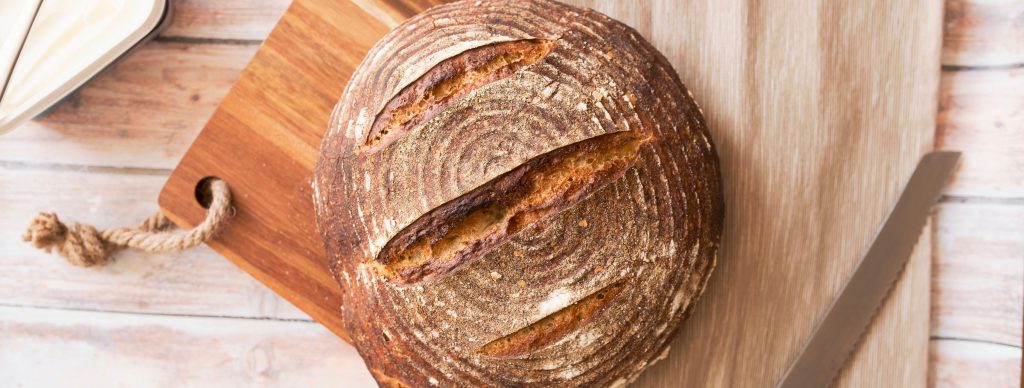Diligent moms and young shoppers top the list of GF trendsetters, and popular books including Grain Brain and Wheat Belly help drive the trend. For people who embark on the personal experiment of going GF without any particular diagnosis, those who stick with it say they feel remarkably better. Digestive complaints, skin issues, mood, inflammation, autoimmune disease… gone or dramatically reduced.
Why do so many people have “gluten issues” nowadays? While some of it might be more trend than reality, there are several key reasons why an individual might do better ditching the gluten…
Celiac Disease: This is a medically recognized autoimmune disorder in which the body mounts an immune attack on the small intestine whenever the person eats gluten. Over time, this causes major health issues, including increased risk of malnutrition, rashes, diabetes, infertility, osteoporosis, cancer, and more. Only a small number of people seeking a gluten-free diet actually have Celiac disease, but having a close relative with the disease dramatically ups your risk (from 1 in 100 to 1 in 10 chance). Solution? The only real treatment is to avoid gluten completely – no cheating, not even traces. Tests are more reliable if performed while you’re still eating gluten. Learn more here.
Gluten Allergy: Varying degrees of other allergic responses may underlie gluten sensitivities, including IgG and IgE responses to gluten or other proteins in gluten. More subtle gluten allergy symptoms may look a bit like Celiac disease, but the autoimmune component is generally not present. Reactions can range from severe – such as the IgE-related anaphylaxis – to vague and chronic IgG symptoms. Solution? You may need eat a completely gluten-free diet or be fine with occasional small doses or less gluten-rich forms of wheat. Different tests are called for to rule out the two types of allergic responses, and tests are more reliable if performed while you’re still eating gluten.
FODMAPs: Carbohydrates, not gluten, may be the real culprit behind much of our “gluten intolerance,” especially that which coincides with digestive disturbance, flatulence, and Irritable Bowel Disorder (IBS). Many different foods contain certain types of carbohydrates that gum up the works in sensitive digestive systems. High FODMAP (Fermentable Oligo-, Di-, Mono-saccharides and Polyols) foods include gluten-rich grains, dairy/lactose, beans, inulin fiber and inulin-rich root crops, garlic, onions, sugar alcohols like xylitol and sorbitol, as well as some fruits. Studies have shown that 70 percent of people with IBS improved with a low FODMAP diet, and that many with “gluten issues” were actually more reactive to FODMAPs than gluten. Interestingly, FODMAP starches and fibers actually feed beneficial bacteria. But if you’re short on the good guys or have an overabundance of the bad, high FODMAP foods ferment in the gut, draw in water, and cause cramping, diarrhea, and IBS symptoms. Solution? Initially, most experts recommend a low FODMAP diet (which can be extremely limiting) – more details here and here – until symptoms abate. Give your gut a chance to heal. Then slowly reintroduce individual foods to see which ones you do or don’t tolerate. As a practitioner who finds digestive health and the human microbiome fascinating, I feel the FODMAP diet ignores the underlying issue: lack of good beneficial bacteria in the gut. Cutting out FODMAPs just removes beneficial bacteria’s food and makes the bad guys less cranky. A low-FODMAP diet may initially stop the irritation, but consider slowly adding sources of beneficial bacteria into your diet (through probiotic supplements, fermented veggies, maybe fermented dairy) as you gradually integrate more high-FODMAP and high-fiber foods into your diet to support your microbiome. Soothing, gut-healing herbs including marshmallow root, slippery elm, and licorice in tea may also help heal gut irritation and damage. You may also find that small doses of fermented or sprouted grains and slow-fermented (think: sourdough, levian) or sprouted grain products are more easily digested.
Glyphosate Reaction: Some gluten-sufferers marvel at how they can travel abroad and eat European pasta and bread with impunity yet feel miserable when they eat it here in the States. Why? We don’t know for sure, but one reason could be the way in which grains have recently begun treated by some farmers. Recent research has called attention to the trend of using glyphosate (Roundup) herbicides in grain production and the increase in both Celiac disease and other forms of gluten intolerance. An increasing number of conventional grain farmers are spraying Roundup on their crops just before/at harvest time. This isn’t to suppress weeds, it’s to increase yield. As the herbicide kills the crop, the plant attempts to reproduce by popping out its seeds/grains. While the practice may not be widespread among all grain farmers, grains treated in this manner are mixed into the grain supply so that any products made with grain are likely to be contaminated. Solution? Buying certified organic products is the only way to be sure your grains are “clean.” (I asked the folks at our beloved King Arthur Flour, and they confirmed that even some of their conventional grain farmers use the practice. Very disappointing.) Although officially Roundup and its use on our food is considered safe for consumption, several studies have found that ingestion can damage the gut, aggravate the immune system, cause an imbalance in gut microbes, and a range of other health issues.
Modern Wheat: Years of scientific natural and (to a much lesser extent) genetically modified plant breeding to increase yields now has put wheat on our plate that is very different from what our agrarian ancestors ate. Solution? Some people do just fine with heritage and low-gluten varieties of wheat, including spelt and farro, even though they are still wheat and do contain some gluten.
Glycemic Index of foods high in gluten and wheat tends to be high, meaning that they break down into simple sugars rapidly in your body, causing blood sugar spikes, crashes, and insulin problems. Eating too many high-glycemic foods eventually puts you at a high risk of insulin resistance, pre-diabetes, type 2 diabetes, obesity, sugar cravings, hardening of the arteries, high triglycerides and cholesterol, and high blood pressure. “Fuzzy brain” symptoms may be a result of other types of “gluten issues,” but they can also simply mean that your body is not doing well on so many carbs (be them from grains, fruit, processed food, sugar, etc.). Solution? Limit your high-glycemic, high-carbohydrate food intake. When you do eat carbs, aim for whole-food, high-fiber sources such as whole grains, root vegetables, seeds, berries, nuts, and beans. Be sure to pair them with protein and good fats to mellow the sugar rush.
I find that many break their gluten-free experiment with high-glycemic, indulgent junk food like pizza. So much can make your body cranky with that! Instead, try breaking it with just a few whole wheat crackers, a small serving of farro, or one piece of sprouted bread, and be sure to pair it with protein and good fats.
Regardless of your the cause of your “gluten issues,” remember to focus your diet on these super healthy, nutrient-dense, and naturally gluten-free foods:
- Organic gluten-free grains including quinoa, millet, amaranth, buckwheat, rice, corn, and certified gluten-free oats
- Winter squash and root vegetables including potatoes, sweet potatoes, rutabaga, turnips, beets
- Plenty of green (or red, purple) leafy vegetables
- Fruit, especially berries
- Beans, lentils, nuts, seeds
- Low-mercury, sustainably caught or farmed fish and shellfish
- Good fats from olives, coconuts, avocado, nuts, seeds, and maybe dairy
- Organic whole and fermented soy (tempeh, miso, tofu, edamame) in moderation (if you tolerate it)
- Organic and pasture-raised backyard eggs (if you tolerate them)
- Organic and pasture-raised dairy in moderation if at all (if you tolerate it)
- Organic and pasture-raised (“grass fed”) meat, poultry, etc. in moderation if at all
Most gluten-free packaged foods should be considered a treat and not standard fare. Common GF flours such as tapioca starch, rice flour, etc. are high-glycemic and full of empty calories. You’re better off eating primarily (or completely) whole foods that are naturally gluten-free.
Getting Guidance: When in doubt, don’t hesitate to seek the aid of an integrative physician, registered dietitian/nutritionist, naturopathic doctor, or herbalist to develop a plan customized for your needs. Many excellent practitioners can be found in New Hampshire. Doctors, naturopaths, and dietitians can usually order tests to sleuth out Celiac disease, IgG, or IgE allergies, as well as insulin and blood sugar. Remember that these tests tend to be most accurate if performed before you go on a gluten-free diet.
Maria runs Wintergreen Botanicals Herbal Clinic & Education Center in Allenstown. This blog originally appeared on the Concord Co-op website and has been reprinted with permission.
The statements made on this blog have not been evaluated by the FDA and are not intended to diagnose, prescribe, recommend, or offer medical advice. Please see your health care practitioner for help regarding choices and to avoid herb-drug interactions.
Photo by Ben Garratt on Unsplash








